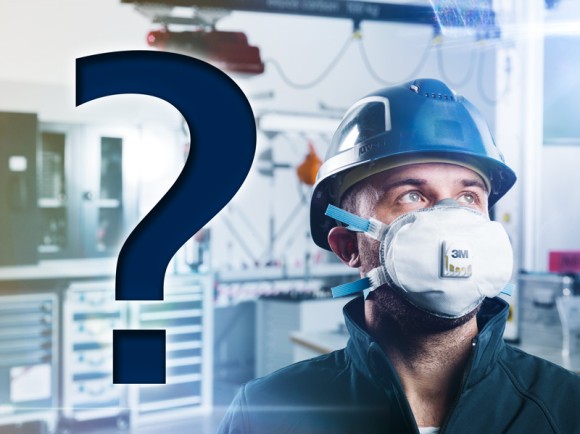
Respiratory Protection – Breathe without risk
Our respiratory masks provide maximum safety for drilling, grinding, welding, and other dust-intensive tasks. Choose from numerous models with different filter classes to find the right respiratory protection for your needs.
To the productsWith us, you are guaranteed to find the right respiratory protection!
For the sake of your lungs, avoid inhaling fine dust and harmful substances! Our respiratory masks provide maximum safety for drilling, grinding, welding, and other dust-intensive tasks. The particle-filtering half masks with exhalation valves ensure optimal climate management. They cover the mouth and nose and, thanks to their optimized design, are perfectly compatible with safety goggles. A secure and comfortable fit is ensured by the continuous headband. Choose from our models with different filter classes for protection against toxic and harmful, or less harmful, dust, mists, and fumes. Do you need protection against gases and vapors? Then opt for our half masks .
Our respiratory masks by filter class
Particle filters are available in three protection levels. The more toxic or carcinogenic a substance is, the higher the required level.
*Filters allow up to x times the workplace exposure limit.
Gas and vapor filtering respiratory masks
Gas and particle filters are also divided into different classes, depending on their capacity or efficiency. The higher the class, the more effective the protection.
| Filtertyp EN 14387 | Protection against... | Classes | Color |
| A | Gases and vapors from organic compounds, boiling point > 65°C (e.g., solvents, turpentine, gasoline) | 1, 2, 3 | ochre |
| AX | Gases and vapors from organic compounds, boiling point ≤ 65°C | 1, 2, 3 | ochre |
| B | Inorganic gases/vapors (e.g., chlorine, bromine, hydrogen sulfide) | 1, 2, 3 | gray |
| E | Acidic gases/vapors (e.g., sulfur dioxide, hydrogen chloride) | 1, 2, 3 | yellow |
| K | Ammonia, ammonia compounds (e.g., dimethylamine) | 1, 2, 3 | green |
| CO | Carbon monoxide | 1, 2, 3 | black |
| HG | Mercury | 1, 2, 3 | brown |
| NO | Nitrous gases including nitrogen monoxide | 1, 2, 3 | blue |
| Reaktor | Radioactive iodine, including radioactive iodide | 1, 2, 3 | orange |
| P | Particles | 1, 2, 3 | white |
Combination filter
| 1-P2 / 2-P2 | Gases, vapors, solid and liquid particles of harmful substances |
| 2-P3 | Gases, vapors, solid and liquid particles of toxic and highly toxic substances |
Examples of use for particle-filtering half masks
The specified filter classes are minimum requirements and serve as a guide.
| ACTIVITY | HAZARDOUS SUBSTANCES | PROTECTION CLASS | ||
| FFP1 | FFP2 | FFP3 | ||
| WOODWORKING | ||||
| Softwood: Sanding and cutting | Fine particles, wood dust | x | ||
| Hardwood (oak, beech, tropical wood): Sanding and cutting | Fine particles, wood dust | x | ||
| Sanding/Brushing off paint | Fine paint particles | x | ||
| Sanding/Brushing off paint (chromium-containing coatings) | Fine paint particles | x | ||
| Water-based coatings containing copper/chromium/arsenic | Fine paint mist | x | ||
| CONSTRUCTION AND ALLIED TRADES | ||||
| Cement work, plastering, tiling, roofing | Cement/plaster/tile/brick dust | x | ||
| Masonry: Cutting, drilling, demolition | x | |||
| Asbestos: Small-scale work | Fibers | x | ||
| Roof insulation (glass and mineral fibers) | Dust and fibers | x | ||
| Filler/Putty: Sanding | Dust | x | ||
| WELDING WORK | ||||
| Welding stainless steel and aluminum | Metal and aluminum oxide fumes | x | ||
| Brazing | Fumes | x | ||
| METALWORKING | ||||
| Metal: Drilling, grinding, milling, cutting | Metal dust | x | ||
| High-alloy steel/stainless steel: Drilling, grinding, milling, cutting | Metal dust | x | ||
| DISPOSAL / CLEANING WORK | ||||
| Waste sorting and disposal | Dust, fungi | x | ||
| Disposal of medical waste | Bacteria, spores | x | ||
| Sweeping floors | Dust (non-toxic) | x | ||
| Radioactively contaminated dust | Dust | x | ||
| AGRICULTURE | ||||
| Animal diseases/Treatment of sick animals | Bacteria, viruses | x | ||
| Handling mold spores | Spores | x | ||
| Handling hay, grain, flour | Dust | x | ||
| MEDICAL/CARE/HEALTH | ||||
| Allergies, pollen, house dust, animal hair | Dust, particles, spores | x | ||
| Bacteria, viruses, infections, Legionella | Bacteria, viruses | x | ||
How do particle-filtering half masks differ?
Particle-filtering half masks, also commonly known as dust masks, dust protection masks, or fine dust masks, are distinguished as preformed or foldable.
Preformed masks have the advantage of being easy to put on.
Foldable masks, on the other hand, are particularly practical if you need to carry the mask with you and use it later in the day.
How long can I use my respiratory mask?
Particle-filtering half masks are designed for single use (one workday of 8 hours). Filters for half and full-face masks, however, can be used multiple times. Regardless, both particle-filtering half masks and filters should be replaced promptly if breathing resistance increases or if you notice the taste or smell of gas.

Did you know that a dust lung starts gradually?
Many professions are exposed to harmful dust. As a result, dust lung is one of the most common occupational diseases.
Dust lung is particularly dangerous because it starts gradually, and those affected may not experience the first signs until years later, often not until retirement age.
Early symptoms can include shortness of breath during physical exertion, a persistent cough of unknown cause, or even pneumonia.
Protect your respiratory system. We have what it takes.





